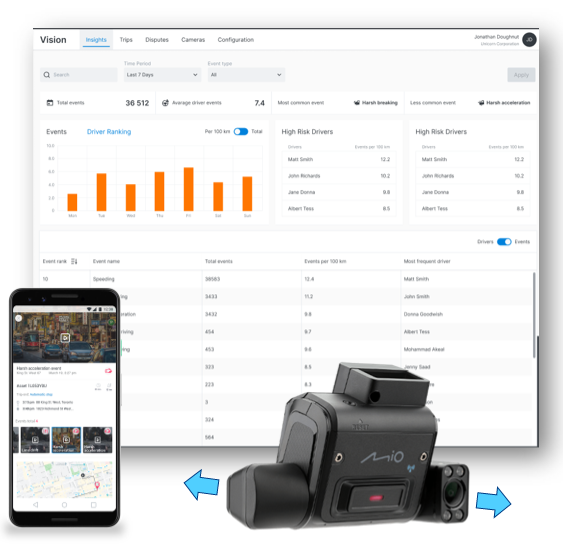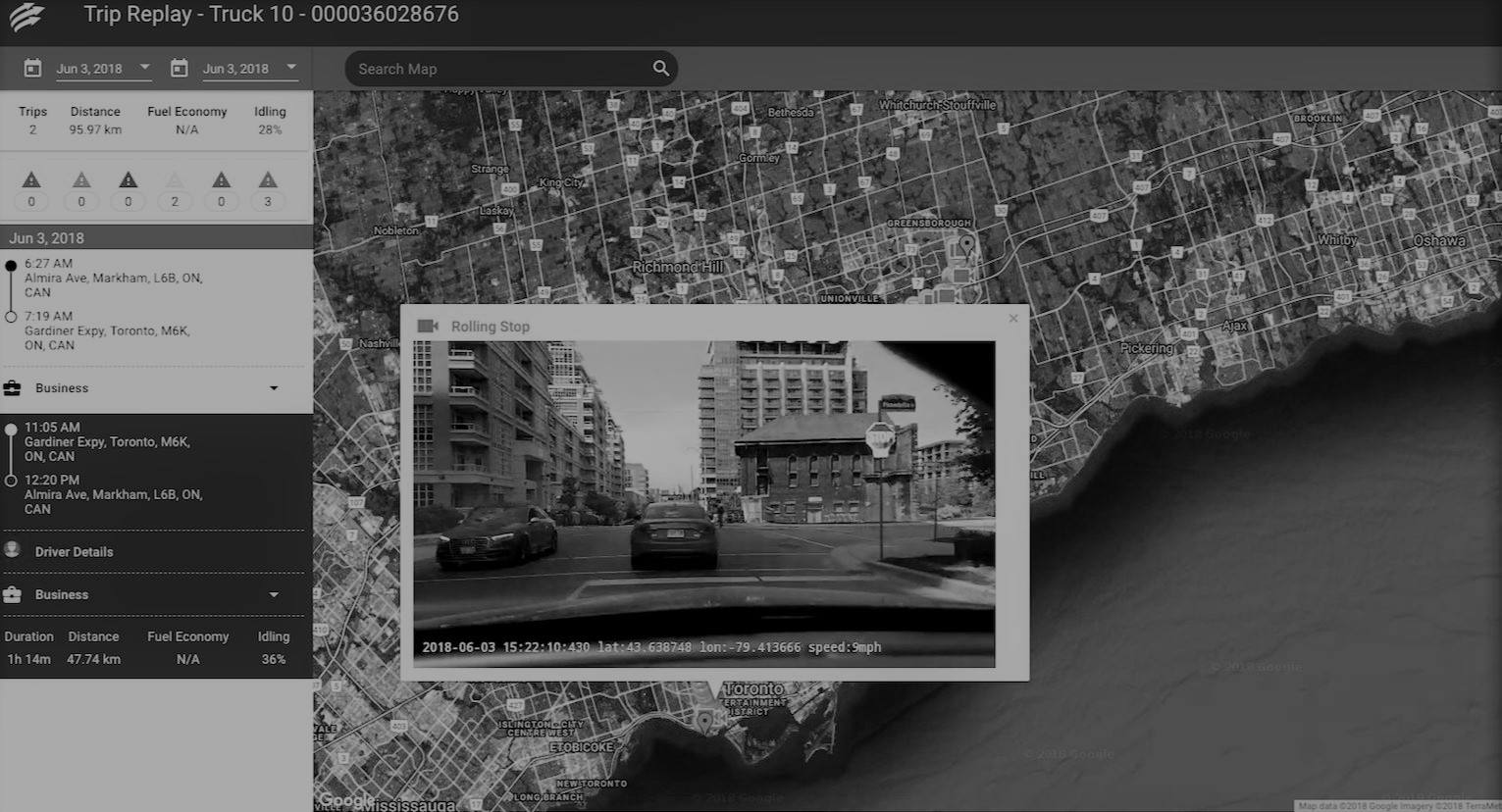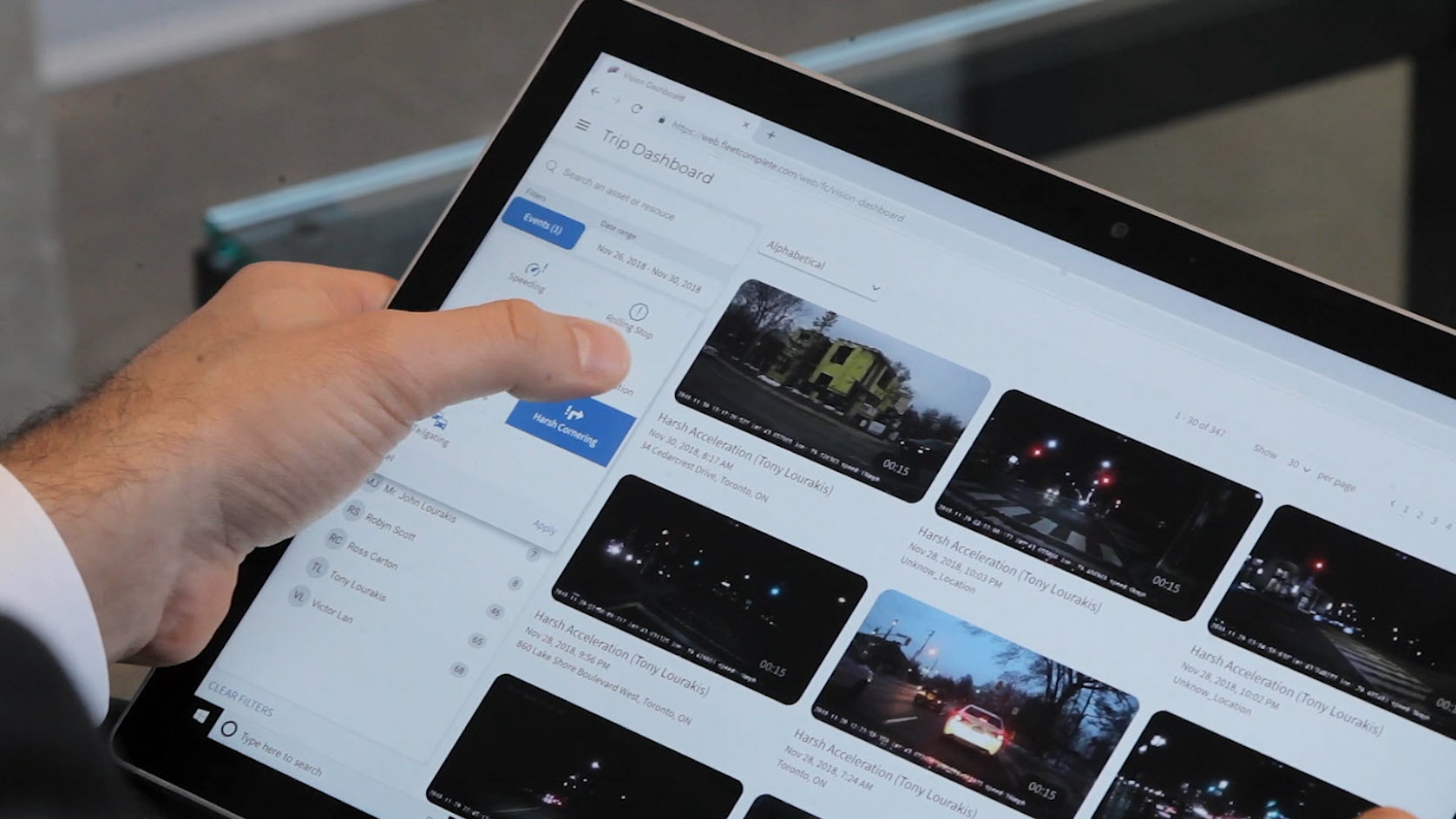What is a Fleet Safety Program?
A fleet safety program is a coordinated effort between an organization’s executives and employees which is designed to ensure everyone understands and adopts behaviors that safeguard:- Drivers and their driving records
- The company’s vehicles, assets, and reputation
- The cargo and passengers the vehicles transport
- Other drivers and vehicles on the road
What to Look for in a Video Telematics Solution
When deciding on a telematics solution, look for software and devices that offer:- A camera that captures sharp, clear footage with broad sight lines. This is critical to justify actions like harsh braking to avoid an accident.
- Fleet safety dashboards and event scoreboards ranking your safest and riskiest drivers.
- Dual-facing view of the driver and the road simultaneously to provide essential context, such as demonstrating that a driver was focused on the road.
- Live video streaming enables fleet managers to “drop in” and provide real-time driver coaching.
- Audio, desktop and email alerts for fleet managers.
- Driver-request buttons for proactive event recording for post-trip review.
- Rule customizations, including rule thresholds for light, medium, and heavy-duty commercial vehicles.
- A map view of recent trips so fleet managers can see when and where events occurred along the trip.
Coaching Risky Drivers to Become Defensive Drivers
Historical driver habits are often the best indicators for future behaviors, so deterring them is critical to protecting your fleet assets. According to another ATRI report, drivers who have been involved in collisions are 113% more likely to be involved in another crash than those that haven’t. Drivers convicted of these infractions are the most likely to be involved in a future collision and should be closely monitored:- Failure to yield right-of-way – 141%
- Failure to signal – 116%
- Reckless driving – 104%
- Failure to obey traffic sign – 85%
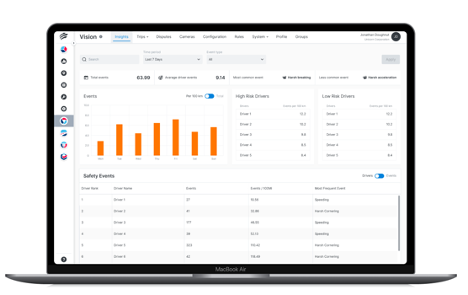
Caption: The FC Vision Dashboard
How Does a Video Telematics Platform Influence a Fleet Safety Program?
Video telematics detects and alerts drivers of unsafe driving habits like distracted driving and speeding. The data that AI-powered cameras and applications gather help identify drivers that exceed the speed limit, multitask while driving, and brake suddenly.
Fleet managers should talk candidly with drivers about the safety benefits of intelligent cameras and applications. Watching video demonstrations of the technology can also build trust and ease suspicion that could arise if the technology is implemented without any warning or explanation.
When comparing telematics solutions, look for one that offers a fleet safety leaderboard that:
- Identifies the safest and least safe drivers within a specific timeframe.
- Captures which unsafe behaviors are most and least common.
- Flags how often dangerous driving events occur per 100 miles for each driver.
- Enables employees to watch their driving events on their mobile devices.
You should also consider investing in a real-time digital leaderboard to recognize your top drivers and motivate the rest to improve their habits behind the wheel.
Enhance Safety with Collision-Avoidance Technology
Advanced Driver Assistance System (ADAS) systems and computer vision help enhance driver road awareness and fleet safety program effectiveness. The insights from the table and trip map below provide up-to-the-minute visibility into your drivers’ behaviors and insights into opportunities for fleet optimization.
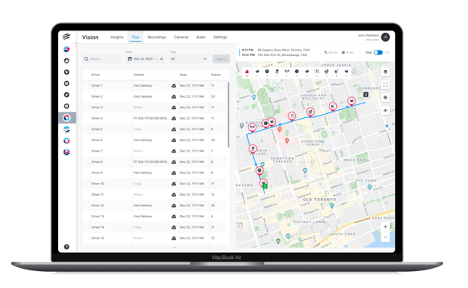
Caption: FC Vision Trip logs and Event Mapping
A video telematics platform with an ADAS can identify precisely when a driver is texting while driving or showing signs of drifting off to sleep (and possibly off the road.) A voice alert can bring the driver’s attention back to the road ahead and inform their fleet manager of the unsafe driving event. One crisis averted could mitigate future ones with alerts and in-vehicle coaching methods. It helps your company avoid fines, collision deductibles and insurance rate increases.
Gamifying Fleet Safety with Video Telematics
Many successful fleets balance unsafe driving violations and safe driver motivation with a gamification approach. In this case, gamification means incorporating point systems, rewards, and competitions into safety training and management programs.
It is an innovative approach to creating a safety-driven culture within their fleet by turning safety training and compliance efforts into a fun, motivating experience. It inspires drivers to adopt safe driving habits and continuously strive to improve their performance. The ultimate goals of fleet safety management gamification programs include:
- Reducing accidents.
- Decreasing fuel consumption.
- Lowering insurance costs.
- Reducing vehicle wear and tear that results from reckless driving.
- Promoting safer conditions for everyone on the road.
Many fleets deduct bonus dollars for each unsafe driving event, while others award drivers with the fewest identified events on their record.
Smart dash cams provide vital context to explain why even your safest drivers speed uncharacteristically or brake suddenly. For drivers who consistently speed, tailgate, or drive while texting, it can be a real moment of truth to see themselves doing so on video or to hear repeated warnings. Alternatively, celebrating team-wide collision-free days and positive customer reviews can increase driver engagement and morale while fostering a safety culture.
If one of your top performers suddenly needs to swerve to avoid a vehicle that drifts into their lane, having that video evidence of their driving anomaly can protect their safe driving leadership position.
Fleet Safety Programs and Driver Retention
According to the National Transportation Institute, companies that incorporate technology and programs that monitor driver safety health, and well-being improve driver retention. This is because they recognize that dual-facing dash cameras demonstrate a commitment to the safety of everyone on the road and can help to protect them from fraudulent claims and unwarranted fines.
Many drivers are not paid for detention time, although in the United States, the Biden-Harris Administration Trucking Action Plan aims to change that.
The U.S. FMCSA is studying how drivers’ time waiting for their load (detention time) contributes to driver resignations and how many drivers speed to make up for lost time, especially when paid by the mile.
Enhance Your Fleet Safety Program for the Unpredictable Road Ahead
Predicting how challenges like driver shortages, supply chain threats, and rising fuel costs will evolve is difficult. Yet businesses that rely on commercial vehicles to deliver their products and services must improve their fleet safety programs to meet growing customer demands, compliance requirements, and resource shortages.
To learn more about how video telematics can make your drivers and fleet assets safer, contact our experts.














